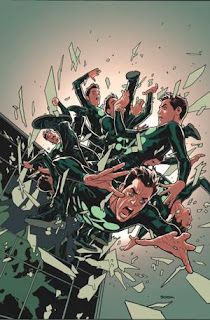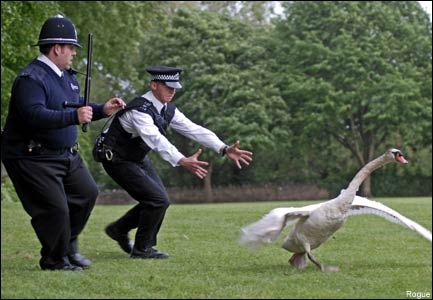
Jamie Madrox has the mutant power of schizophrenia. Ok, so maybe that's not accurate, but at the very least he has very many, very distinct, and very visible personalities. Madrox, otherwise known as the Multiple Man, has the power of creating a duplicate of himself any time he absorbs kinetic energy (i.e. getting punched or snapping his fingers). This allows Multiple Man to create a veritable army of Multiple Men, something quite useful in a fight. What is interesting about this power is that each duplicate, or 'dupe', of Madrox exemplifies a unique facet of Madrox's personality. For example, one dupe might be 'the funny one' or one might be 'the scholarly one', some have training as doctors while others are simply soldiers. Unfortunately, as neat as this power is, as is the case whenever the law of conservation of mass is broken, there are plenty of problems...
Whenever Madrox creates a dupe, at some point he must reabsorb it. The absorption of duplicate Jamies can be accomplished by a simple touch from the original Madrox. The dupes are usually very accommodating in regards to this process, however this is not always the case. In a recent issue of Wolverine First Class (which runs in a time line more in touch with the X-Men comic books of the 1980s) the problem of a renegade dupe arises. Madrox 'Prime' (as the true Jamie is sometimes referred to)has created a dupe who is determined to live his own life. Equally determined is Madrox Prime in his quest to reabsorb the dupe. His reasoning is that if the dupe does anything wrong he would be responsible, and as such must preempt this possibly negative scenario. Kitty Pryde, the youngest member of the X-Men, sides with the dupe in this conflict and attempts to persuade Madrox Prime from his attempts at reabsorbing the dupe, accusing him of trying to kill the dupe. Madrox retorts that it wouldn't be killing him, that "He's a part of me! He's like...a toenail clipping! Or hair! If my hair started begging not to be cut, how seriously would you take it?" Kitty's response is a very sarcastic "If your hair started talking, that would be pretty cool," and she continues making her point asking "How am I supposed to say that this guy is less deserving of life than you are...?"

This scene very much reminds me of debates on abortion. People often justify abortion by getting into technical debates over what makes a life. Unborn children are referred to as nothing more than clumps of tissue (not much different than what Madrox Prime says when he likens his dupe to hair or toenail clippings). However, these 'clumps of tissues' grow into something that can talk, and I, like Kitty, do not understand why they are considered any less deserving of life than we are.
This parallel is made even more explicit in an issue of the comic book X-Factor (#39 to be precise), the monthly series that features Multiple Man as the head of what is essentially a mutant detective agency. In this issue (many spoilers to come, though I strongly recommend that you read this series as it is very smart and thought-provoking) the character Theresa Cassiday (aka Siryn, a mutant who wields a 'sonic scream' who you might have seen briefly in the raid on the X-Mansion in the second X-Men movie) gives birth to a son...Madrox's child, quickly christened Sean.
 This moment of joy turns very sour when the happy couple finds out that the child's father is not exactly who it was thought...Madrox is not literally the father, instead it is one of his dupes. This is revealed when Madrox Prime takes the infant in his arms and accidentally reabsorbs him. It turns out that "the offspring of a dupe isn't really anything more than a dupe". This incident puts the already hot-headed Siryn into a murderous rage and sends Jamie towards grief-stricken insanity (he later is rescued from his own suicide attempts). Clearly this issue is not to be taken lightly. While the 'death' of Sean very much mirrors an abortion, even in the language used in referral to it, the actions taken in response to it demonstrate a sense of loss that surely does not come from the loss of some tissue. Yes, the infant dupe is easier to identify with as it takes the form of a completely developed baby, but the parallels are there. The loss of something that "isn't really anything more than a dupe" causes Jamie's fiancee to threaten to kill him upon next seeing him and drives Madrox himself on a suicidal path. The actions taken by these characters speaks louder than their words, life is precious and should not be taken.
This moment of joy turns very sour when the happy couple finds out that the child's father is not exactly who it was thought...Madrox is not literally the father, instead it is one of his dupes. This is revealed when Madrox Prime takes the infant in his arms and accidentally reabsorbs him. It turns out that "the offspring of a dupe isn't really anything more than a dupe". This incident puts the already hot-headed Siryn into a murderous rage and sends Jamie towards grief-stricken insanity (he later is rescued from his own suicide attempts). Clearly this issue is not to be taken lightly. While the 'death' of Sean very much mirrors an abortion, even in the language used in referral to it, the actions taken in response to it demonstrate a sense of loss that surely does not come from the loss of some tissue. Yes, the infant dupe is easier to identify with as it takes the form of a completely developed baby, but the parallels are there. The loss of something that "isn't really anything more than a dupe" causes Jamie's fiancee to threaten to kill him upon next seeing him and drives Madrox himself on a suicidal path. The actions taken by these characters speaks louder than their words, life is precious and should not be taken.There is one case of a dupe that is not absorbed. Jamie, in a quest to absorb all his dupes, finds one duplicate who has created a life that is entirely his own. Going by the name John Madrox, the dupe is a pastor with his own congregation, church, and family.

Needless to say, the voice that answers John from off panel in the above picture is not that of the God he is praying to. Instead he turns to find a very cynical, very depressed, Madrox Prime. In their initial encounter John makes his case and eventually convinces Jamie to not absorb him. I find it interesting that the one dupe who receives his own life becomes a priest. This alerts to the scriptural approach we should take towards the issues represented by Multiple Man. The Bible plainly states that we are not to kill (Exodus 20:13), and while people may go on and on suggesting that abortion is okay because it is nothing more than removing a clump of tissue, my thought is that it would be pretty cool if that little clump of tissue started talking...
'Nuff Said
-Cable






